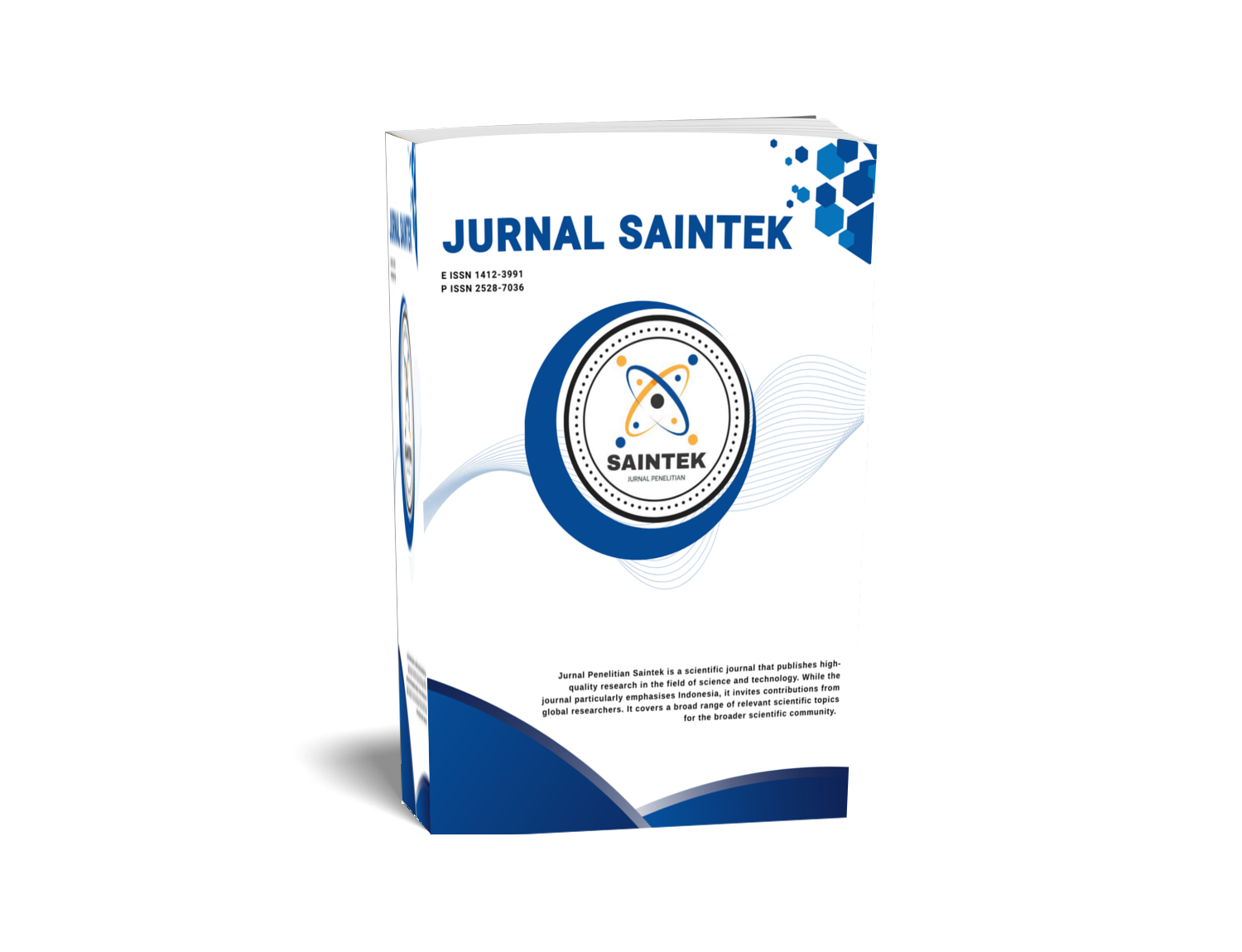Optimasi konsentrasi katalis Natrium Hidroksida pada sintesis 2,5-bis((E)-3,4-dimetoksibenziliden)siklopentan-1-on
DOI:
https://doi.org/10.21831/jps.v1i1.71399Abstract
Penelitian ini dilakukan dengan tujuan untuk sintesis senyawa 2,5-bis((E)-3,4 dimetoksibenziliden)siklopentan-1-on dengan variasi mol katalis NaOH serta mengetahui rendemen senyawa (2E,5E)-2,5-bis(3,4-dimetoksibenziliden) siklopentanon yang telah disintesis. Sintesis dilakukan dengan mereaksikan siklopentanon sebanyak 5 mmol dan veratraldehida sebanyak 10 mmol menggunakan katalis NaOH dengan variasi 5, 10, 15, dan 20 mmol dan pelarut etanol. Proses sintesis berjalan melalui reaksi kondensasi Claisen-Schmidt menggunakan metode microwave assisted organic synthesis selama 60 detik. Hasil sintesis yang diperoleh kemudian dilakukan karakterisasi melalui KLT dan KLT scanner, FTIR, dan 1H-NMR. Hasil penelitian diperoleh senyawa berbentuk serbuk kuning dan hasil karakterisasi menunjukkan bahwa senyawa tersebut merupakan senyawa target (2 E,5E)-2,5-bis(3,4-dimetksibenziliden) siklopentanon. Rendemen senyawa (2E,5E)-2,5-bis(3,4-dimetoksibenziliden) siklopentanon yang dihasilkan oleh variasi mol katalis NaOH 5, 10, 15, dan 20 mmol secara berturut-turut yaitu 71,75%; 60,44%; 118,42%; dan 113,54%. Hasil penelitian ini menunjukkan bahwa katalis NaOH berpengaruh terhadap rendemen hasil sintesis.
Kata Kunci: 2,5-bis((E)-3,4-dimetoksibenziliden)siklopentan-1-on, kondensasi Claisen- schmidt, metode MAOS
Optimization of Sodium Hydroxide catalyst concentration in the synthesis of 2,5-bis((E)-3,4-dimethoxybenzylidene)cyclopentan-1-one
Abstract: This study aimed to synthesize the compound 2,5-bis((E)-3,4-dimethoxybenzylidene) cyclopentan-1-one with varying molar quantities of NaOH catalyst and to determine the yield of the synthesized (2E,5E)-2,5-bis(3,4-dimethoxybenzylidene) cyclopentanone. The synthesis was carried out by reacting 5 mmol of cyclopentanone and 10 mmol of veratraldehyde using NaOH catalyst in amounts of 5, 10, 15, and 20 mmol, with ethanol as the solvent. The synthesis process involved Claisen-Schmidt condensation via microwave-assisted organic synthesis for 60 seconds. The synthesized products were characterized using TLC and TLC scanner, FTIR, and ^1H-NMR. The results revealed that the synthesized compound was a yellow powder, and the characterization confi rmed it as the target compound, (2E,5E)-2,5-bis(3,4-dimethoxybenzylidene) cyclopentanone. The yields of (2E,5E)-2,5-bis(3,4-dimethoxybenzylidene) cyclopentanone obtained with NaOH catalyst amounts of 5, 10, 15, and 20 mmol were 71.75%, 60.44%, 118.42%, and 113.54%, respectively. These fi ndings indicate that the amount of NaOH catalyst signifi cantly aff ects the yield of the synthesis.
Keywords: (2E,5E)-2,5-bis(3,4-dimethoxybenzylidene)cyclopentanone, Claisen-schmidt condensation, MAOS method
References
Anisa, D. N., Anwar, C., & Afriyani, H. (2020). Sintesis senyawa analog kurkumin berbahan dasar veratradehida dengan metode ultrasound. Analytical and Environmental Chemistry, 5(01), 74-81.
Bele, A., & Khale, A. (2011). An overview on thin layer chromatography. International Journal of Pharmaceutical Sciences and Research, March, 256-267.
Budimarwanti, C., & Handayani, S. (2010). Efektivitas katalis asam basa pada sintesis 2- hidroksikalkon, senyawa yang berpotensi sebagai zat warna. Prosiding Seminar Nasional Kimia Dan Pendidikan Kimia (pp. 2-10).
Novak, I. (2020). Reversible reaction: Extent of reaction and theoritical yield, Journal of Chemical Education, 97(2), 443-447.
Kumar, S., Jyotirmayee, K., & Sarangi, M. (2013). Thin layer chromatography: A tool of biotechnology for isolation of bioactive compounds from medicinal plants. International Journal of Pharmaceutical Sciences Review and Research, 18(1), 126-132.
Moseley, J. D., & Kappe, C. O. (2011). A critical assessment of the greenness and energy efficiency of microwave-assisted organic synthesis. Green Chemistry, 13(4), 794-806. https://doi.org/10.1039/c0gc00823k.
Pambudi, W. (2013). Efektivitas sintesis hidroksikalkon menggunakan katalis NaOH dan NaOH+ZrO2 monmorinolit melalui metode konvensional, microwave assisted organic synthesis (MAOS) dan Sonokimia. Universitas Gajah Mada.
Sheldon, R. A. (2012). Fundamentals of green chemistry: Efficiency in reaction design. Chemical Society Reviews, 41(4), 1437-1451. https://doi.org/10.1039/c1cs15219j
Wiratama, & Budimarwanti. (2019). Benzylidene ) acetone by cross aldol condensation reaction using microwave assisted organic synthesis (MAOS) method. The Science and Science Education International Seminar Proceedings 2019 Promoting Science for Technology & Education Advancement Rektorat UNY Building (pp. 48-53).
Downloads
Published
How to Cite
Issue
Section
Citation Check
License
Who Can Submit?
Any individual may submit an original manuscript for consideration for publication in Jurnal Penelitian Saintek as long as they hold the copyright to the work or are authorized by the copyright owner(s) to submit it. Authors retain initial ownership of the copyrights to their works prior to publication, except in cases where, as a condition of employment, they have agreed to transfer copyright to their employer.
User Rights
Jurnal Penelitian Saintek is an Open Access journal. Users are granted the right to read, download, copy, distribute, print, search, or link to the full texts of articles, provided they comply with the conditions of the Creative Commons Attribution-ShareAlike License 4.0 (CC BY-SA 4.0).
https://creativecommons.org/licenses/by-sa/4.0/
Author Rights
Authors retains copyrights.
Jurnal Penelitian Saintek by http://journal.uny.ac.id/index.php/saintek is licensed under a Creative Commons Attribution-ShareAlike 4.0 International License.









